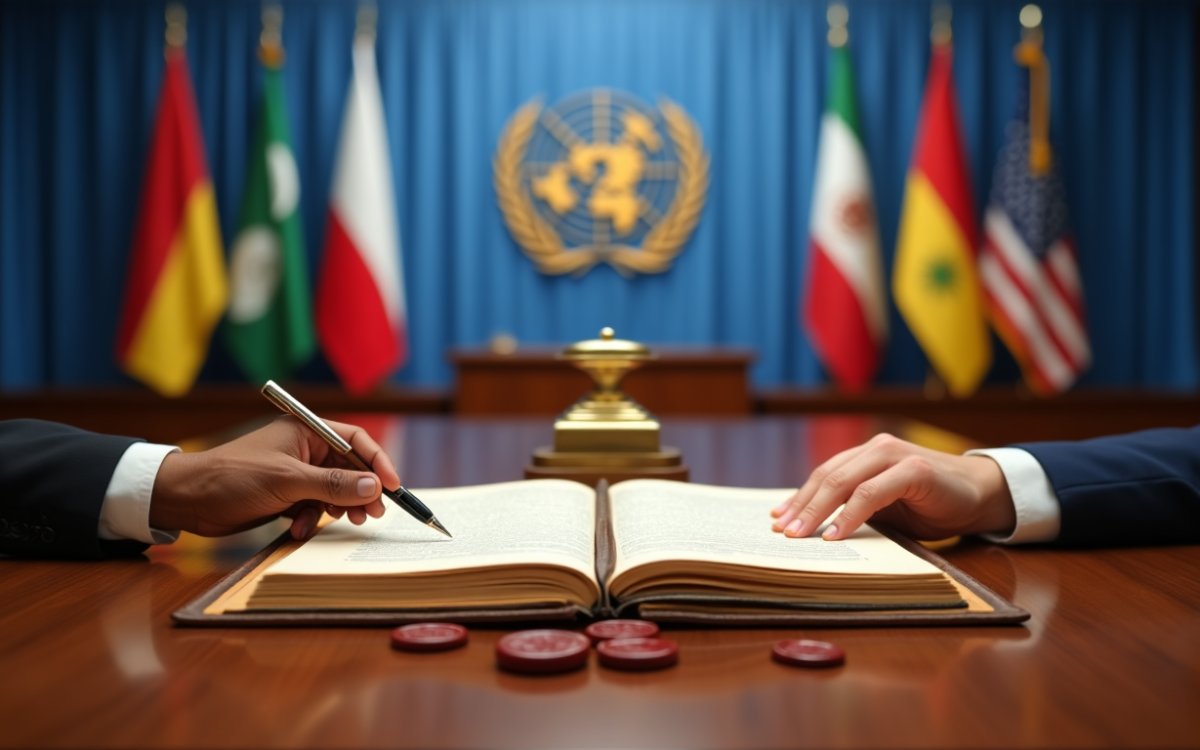The United States Constitution demands a two-thirds Senate approval before any treaty can be ratified. This requirement highlights how seriously international law takes treaty ratification, as these agreements become binding commitments between nations.
Treaty ratification means much more than just signatures on documents. The process covers multiple areas like human rights, disarmament, and international crime. The Geneva Conventions of 1949 and treaties like the International Covenant on Civil and Political Rights show how ratification shapes global cooperation and enforcement.
This piece explores the complete journey of treaty ratification, from the original negotiation phase to international enforcement mechanisms. You’ll learn how states direct the treaty process, face enforcement challenges, and discover why some treaties succeed while others lose support and face withdrawal.
The Pre-Ratification Treaty Process
The treaty-making process starts way before ratification happens. Several significant stages need to happen first. Each stage needs close attention to detail and must follow protocols that are decades old. These first steps are the foundations of how treaties work and how we enforce them.
Negotiation Phase: Setting the Groundwork
Treaty negotiations start after the Secretary of State authorizes the process. Representatives from different nations then involve themselves in deep discussions to agree on what they want. They outline what activities the treaty covers, check if their proposed actions are legal, and see how this fits with their relationships.
The Ministry of Foreign Affairs usually guides these negotiations. They work with other government departments to make sure everyone’s interests are represented properly. You’ll find three main groups at the treaty table: people from each country and sometimes a neutral group to help things along.
Negotiators set up timelines, ways to make decisions, and how to solve disagreements. This groundwork helps create a treaty that works for everyone.
Drafting the Treaty Text: Legal Precision Matters
After agreeing on basic terms, the focus moves to writing the treaty with exact legal wording. A well-laid-out treaty has:
- Title and preamble that sets the scene
- Substantive clauses showing rights and duties
- Final clauses about procedures
- Testimonium and signature blocks
People writing these documents must follow special rules about form and structure. To name just one example, both sides must be equal, and each person signing must have legal authority from their government. The “alternat” principle applies in two-party agreements, where each country’s name appears first in their copy.
Writers must clearly state how things will be paid for if they need special funding. The text also needs to spell out what power any joint committees or councils will have.
Signature Stage: What It Actually Means
In stark comparison to what many think, signing a treaty doesn’t mean immediate agreement. The Vienna Convention on the Law of Treaties says a signature mainly proves the document is real and shows the country wants to keep going with the process.
Different types of signatures mean different things legally:
Simple Signature (needs ratification later): This doesn’t mean final agreement but lets the country move toward ratification. The country must still avoid doing anything that would hurt the treaty’s goals.
Definitive Signature: This means immediate agreement, which we see more in simpler agreements.
Signature ad Referendum: Someone can sign “ad referendum,” and this only becomes final when their government confirms it.
So knowing what type of signature is being used helps everyone understand what it means legally.
Domestic Review: Getting Ready for Ratification
Countries must finish their own legal processes before they can ratify a treaty. The ministry in charge of the treaty starts by analyzing everything and gathering documents.
The lead ministry works with their government’s legal team, often in the Foreign Affairs office, to prepare ratification papers. This office figures out who needs to approve the ratification – parliament or executive – based on their constitution.
They need a full picture of current laws to see what new rules or changes might be needed. Some countries need their courts to check if everything matches their constitution, especially in federal systems where they need to talk to state governments.
This complete domestic review helps countries fulfill their promises once they ratify. It also gets everyone ready for what will change, which reduces pushback after ratification happens.
What Does Treaty Ratification Actually Mean?
Ratification is a formal act where a state confirms its consent to be bound by a treaty. Unlike earlier treaty stages, ratification creates binding legal obligations that affect both domestic and international relations by a lot.
Legal Definition of Ratification
In international law, ratification is the act through which a state shows its consent to be bound by a treaty when parties want to express consent this way. This process serves several key purposes. It gives nations time to get domestic approval and create legislation that puts the treaty into effect at home.
The power of ratification comes from its legal effects. A ratified treaty becomes binding on the state right away. Many legal systems give ratified treaties the same status as federal laws. This change in legal status explains why states take such care when they ratify treaties.
The ratification process is different in various political systems. Legislative approval comes before ratification in parliamentary systems. The U.S. Constitution gives the president power to make treaties “by and with the Advice and Consent of the Senate,” but only if two-thirds of present senators agree. This requirement shows how serious treaty commitments are under international law.
Ratification vs. Signature: Key Differences
People often mix them up, but signing and ratifying are two separate legal actions with their own effects:
| Aspect | Signature | Ratification |
|---|---|---|
| Legal Effect | Expresses intention to comply | Creates binding obligation |
| Timing | Earlier in process | After domestic approval |
| Function | Authentication method | Consent to be bound |
| Obligations | Creates limited good faith duties | Establishes full treaty obligations |
A state’s signature just shows it plans to follow the agreement—this isn’t binding yet. The signature proves the document’s authenticity and shows the state wants to continue with the treaty process. The signing state can move toward ratification and must avoid actions that would hurt the treaty’s goals.
States ratify treaties after finishing their internal procedures. They tell other parties they agree to be bound, which turns the document from a proposal into binding international law.
The U.S. Senate doesn’t ratify treaties directly. The Committee on Foreign Relations reviews them first, then the Senate votes to approve or reject a ratification resolution. The actual ratification happens when the United States and other countries exchange formal documents.
The Instrument of Ratification: Documentation Requirements
The ratification instrument—a formal document showing a state’s consent—must meet certain standards. The Head of State, Head of Government, or Foreign Minister must sign it. Someone else can sign if they have the right authority.
Each document needs the treaty’s exact title, date, and where it was signed. It must clearly state the government’s intention to follow the treaty and observe its rules.
Two countries exchange these instruments for bilateral treaties. For multilateral treaties, a depositary collects ratifications from all states and keeps everyone updated. The deposit takes effect when the depositary receives it.
Notes verbales without signatures aren’t acceptable. Every detail matters in the ratification process to meet international legal standards fully.
Domestic Treaty Ratification Procedures
Countries must clear several domestic hurdles after signing a treaty. Each nation’s political system creates its own unique path to make treaties legally binding.
Parliamentary Systems: Legislative Approval Process
Legislative approval comes before formal ratification in parliamentary systems. The UK Parliament reviews treaties for 21 sitting days under the Constitutional Reform and Governance Act 2010. The House of Commons holds the power to stop ratification through repeated resolutions against it, though it can’t modify treaties.
Parliament’s actual role stays quite limited:
- Debates and votes aren’t required
- Treaties can’t be changed
- No direct role during negotiations
- Time constraints limit committee review
Dutch law makes parliamentary approval necessary before any treaty ratification. Italy groups treaties into two types: “accordi in forma semplice” (simplified agreements) and “accordi in forma solenne” (formal agreements). Formal agreements need explicit parliamentary approval if they “have a political nature, require arbitration or a legal settlement, entail change of borders, spending or new legislation”.
Presidential Systems: Executive-Legislative Dynamics
Presidential systems split power between executive and legislative branches differently. The U.S. Constitution shows this clearly. It gives the President authority “by and with the Advice and Consent of the Senate, to make Treaties, provided two-thirds of the Senators present concur“.
The U.S. has found different ways to handle treaties since World War II:
- Congressional-Executive Agreements: Both houses of Congress need simple majority approval instead of two-thirds Senate approval
- Sole Executive Agreements: Presidents make these without Congress
- Executive Agreements Pursuant to Treaties: These stem from previously approved treaties
Only 6% of international agreements since 1990 have gone through formal Senate treaty processes. Most U.S. international commitments now take the form of congressional-executive agreements.
Presidential systems follow specific steps for treaties. The executive branch handles negotiations first. The legislature reviews the completed treaty next. The executive makes the final call on ratification after approval. The U.S. Senate’s website makes this clear: “The Senate does not ratify treaties—following Senate approval, the president is responsible for ratification”.
Federal vs. Unitary States: Complexity Factors
Federal systems face extra challenges because power splits between central and regional governments. They must check with sub-national entities based on constitutional rules. They also need different government levels to work together for implementation.
Unitary states keep things simpler with centralized decision-making. Both systems still share common hurdles:
- Institutional Constraints: More veto players mean longer ratification
- Voting Requirements: Strict parliamentary rules associate with slower ratification
- Resource Limitations: Many developing nations struggle with implementation
- Political Instability: Government changes can stop ratification progress
Domestic ratification serves as a democratic safety net. It weighs international promises against national needs and lets people discuss important issues. This careful review process might delay or stop treaties from taking effect even after successful international talks.
Post-Ratification Implementation Steps
A country must take several key steps to turn treaty promises into working international obligations after completing its domestic ratification procedures.
Deposit of Ratification Instruments
The ratification process ends up with a formal deposit of documents that show a state’s agreement to be bound. The proper authority must sign these documents – either the Head of State, Head of Government, or Minister of Foreign Affairs. International protocol does not accept unsigned documents or notes verbales.
The United Nations Secretary-General usually acts as depositary for multilateral treaties. Treaties with fewer parties might choose a specific government or international organization. The deposit process follows these steps:
- Prepare the formal document according to prescribed formats
- Deliver the document to the Treaty Section of the United Nations
- Provide translations in English or French when needed
The date when headquarters receives the document becomes the official deposit date. This establishes when the state’s consent takes effect.
Entry Into Force Requirements
Treaties don’t start working right after individual states ratify them. They need specific conditions to take effect. Most multilateral agreements need a set number of states to express consent at the time. States become bound only when they ratify, accept, approve, or accede to the treaty.
Treaties often need additional requirements:
- Waiting periods after required ratifications
- Specific categories of states must be among those who consent
- Rules for provisional use in certain cases
Bilateral treaties might take effect on a specific date, the day of last signature, or after exchanging ratification documents. Treaty writers must balance quick implementation with enough preparation time.
Domestic Legislation Alignment
States must now make their local laws match their international promises. Different legal systems handle this process in their own way. We used two main approaches:
Monist systems (like the United States) automatically make ratified treaties part of federal law. Dualist systems (like Australia) need parliament to create new laws before treaty rules apply locally.
Some treaties need extra laws to work, whatever the legal system. These laws serve several purposes:
- Turn broad treaty rules into clear obligations
- Fix conflicts between treaty rules and existing laws
- Create systems to ensure compliance
- Set penalties for breaking rules
Federal systems might need both national and local government involvement. The U.S. can make states follow these rules if local laws might break international promises.
Administrative Structures Creation
The last step creates the needed administrative framework. Modern treaties often need special groups to watch, check, and enforce the rules.
Different treaties need different structures but usually include:
- National authorities to implement rules
- Technical teams to handle scientific or special issues
- Systems to report compliance efforts
- Ways to solve implementation questions
Money and resources create a big challenge here. Developing nations often struggle to implement everything effectively. Successful treaties often depend on technical help and support between countries.
Administrative setup has become the most expensive part of implementation. Yet it remains crucial to turn diplomatic agreements into real results.
International Enforcement Mechanisms
Sovereign states dominate the international system, which makes treaty enforcement particularly challenging. Several mechanisms have evolved to ensure states comply with their ratified treaty obligations.
Treaty-Specific Enforcement Bodies
International agreements create dedicated systems to monitor and enforce compliance. States must submit regular reports that detail their implementation efforts. Eight UN treaty bodies accept individual petitions from citizens who claim their rights were violated by member states. Treaties also establish specialized committees with specific enforcement powers. These committees can investigate serious violations when they receive credible information. The Committee on the Rights of the Child exemplifies this approach. It oversees compliance with the Convention on the Rights of the Child and reviews individual complaints against states that have ratified the protocol.
UN Security Council's Enforcement Role
The UN Security Council possesses extraordinary enforcement powers under Chapter VII of the UN Charter. It determines threats to peace or acts of aggression and recommends appropriate action. The Council’s authority extends beyond recommendations. It can impose mandatory sanctions, including economic embargoes and diplomatic restrictions, or authorize military intervention. Over the last several years, the Council has sanctioned several countries including Angola, Haiti, Iraq, Libya, and Somalia. The Security Council can also refer cases to the International Criminal Court when international crimes appear to have occurred, as outlined in Article 13(b) of the Rome Statute.
International Court of Justice Jurisdiction
The International Court of Justice serves as the UN’s main judicial body to resolve legal disputes between states. States must consent to its jurisdiction through special agreements, treaty provisions, or optional clause declarations. Many international agreements include clauses that direct disputes to the ICJ if other resolution methods fail. The Court’s judgments bind all parties, but enforcement relies on the Security Council. The Council “may make recommendations or decide upon measures” if parties fail to comply.
Regional Enforcement Systems
Regional human rights systems have become crucial to treaty enforcement in Africa, the Americas, and Europe. These systems combine judicial and non-judicial mechanisms with complementary roles. Each system operates under its respective organization—the African Union, Organization of American States, and Council of Europe. Citizens can seek justice through these systems’ complaint mechanisms when states violate their rights. Regional courts resolve individual complaints and shape treaty interpretation through advisory opinions. States must exhaust their local legal options before bringing violations to regional human rights bodies.
Challenges in Treaty Enforcement
Nations face big hurdles to implement international treaties, even with long-standing enforcement mechanisms. These challenges shape whether treaty obligations lead to real action or stay as mere aspirations.
Sovereignty Concerns and Limitations
International treaty enforcement clashes with state sovereignty. International human rights law restricts how governments treat their citizens within their borders. States often use sovereignty as a bargaining chip against outside oversight. This defense works well when states paint enforcement as foreign interference that threatens their independence. The United States grants foreign sovereigns immunity from property attachment and execution, with few exceptions.
Resource and Capacity Constraints
Treaty implementation suffers by a lot due to financial and institutional limits. Latest data from December 2023 shows 72.6% of States Parties (143 out of 197) have 483 overdue reports. Many developing countries don’t have resilient infrastructure, technical know-how, or money to put treaty provisions into practice. Jamaica’s small Ministry of Foreign Affairs team doesn’t deal very well with the treaty system, which creates report backlogs and slow implementation of recommendations. The UN treaty body system runs short on resources, and the Committee on the Rights of the Child has 69 Member State reports waiting.
Political Will Factors
People often blame “lack of political will” for poor treaty implementation. This term stays vague despite its common use. Political will combines intent and motivation—qualities that are hard to measure. Bureaucratic and political forces make it tough for states to resolve disputes or follow awards before they try every possible challenge. Governments might find enforcement harder when their citizens push back.
Verification and Monitoring Difficulties
Treaty verification comes with complex technical hurdles. Nuclear weapons treaties are tough to monitor because nuclear weapons are smaller than strategic delivery vehicles and satellites can’t track them easily. Telling different weapons apart becomes tricky when delivery vehicles can carry both nuclear and conventional weapons. The backlog of individual communications looks alarming—1,913 communications wait for review before UN Committees as of December 2023. At current speed, it would take about 6.65 years to clear this backlog.
Conclusion
Treaty ratification shapes international relations and global governance in complex ways. Nations must guide themselves from their original negotiations through domestic approval procedures to international enforcement. This process remains vital to establishing global agreements.
Many states don’t deal very well with implementing treaty obligations. Their sovereignty concerns clash with international oversight needs. Resource limitations hold back proper implementation, especially when you have developing nations. Treaty bodies, the UN Security Council, and international courts help maintain accountability through dedicated enforcement mechanisms.
The soaring win of international treaties ended up depending on several core factors:
- Careful negotiation and precise legal drafting
- Full domestic review and approval processes
- Resilient implementation frameworks
- Effective monitoring and enforcement systems
- Steadfast dedication from participating states
Modern treaty systems adapt to tackle emerging global challenges. Diplomats, legal professionals, and anyone interested in international relations need to understand these mechanisms. International treaties will work better in the future by improving enforcement capabilities. This improvement must respect state sovereignty and address resource limits that restrict implementation efforts.







